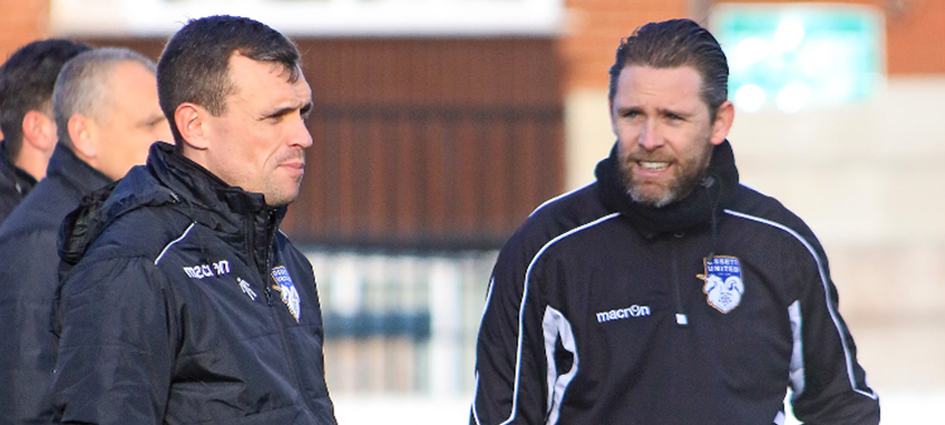
10 top tips for effective touchline communication
- Paul Quinn
- 06 February 2019
FA regional education coordinator, Paul Quinn (above left), and former Sunderland winger, Andy Welsh, are coaches at non-league club Ossett United. In this article they share their top 10 tips for effective touchline communication.
1. Mistakes on the pitch are inevitableAs coaches, how we respond to mistakes will determine if the players draw any learning from what has happened. In particular, young players will look to us to challenge or validate their actions. Even subtle negativity from the touchline towards a mistake, whether it be body language, tone of voice or choice of words, can create an environment where creativity is stifled. During games we are more interested in the positive response of players than the actual errors themselves. We can delve deeper into the learning at half-time or post-match rather than in the moment.
2. Involve more than just the on-field playersSubstitutes are tasked with observing the opposition formation and style of play and recording it on a tactics board ready to share with the rest of the team. We want all players fully engaged in the game. At youth level it is also important to consider parent engagement. At the academy we set home practice tasks for the players based around our focus for the games, so on a matchday parents have a better understanding and connection with what we are focussing on as a team.
3. Leaders create leaders Players are best placed to ensure that messages are communicated effectively on the field. We put a big focus on positive on-field communication. It can often be difficult to communicate clearly with players furthest away in terms of positions, so it is important as coaches we advocate leadership on the pitch. We are also conscious to strike a balance between the coach-led and player-led approach. We encourage players to solve problems when possible, which is often far more powerful.
Delivering technical or tactical information mid-action can cause confusion
4. Less is moreWe have asked ourselves: do we always give instructions from the touchline for a purpose or because we feel obliged to fulfil the role as chief conductor? We always aim to ensure interactions during the game are adding value to the performance, not simply adding noise. Messages are always no more than five or six words - sometimes they are a simple thumbs up - and always refer back to our pre-match briefing and team philosophy.
5. Timing is key
We tend to restrict in-play messages from the touchline to motivational messages, positive reinforcement or basic tactical information. It is crucial we highlight positives and share them regularly with the team. If we need to deliver more detailed technical or tactical messages we always wait for a suitable break in play. From experience, delivering technical or tactical information mid-action can cause confusion.
6. See the big pictureOur overall observation of the game is more important than the verbal communication given during the action. We always aim to take a step back, not to commentate on the game and instead spend time planning some key points we want to address with the players at a suitable break, at half-time or at the next training session. This is done through taking notes. We also use game time to collect information or ask other coaches/substitutes to collect this information, which helps to support our points.
It is important we do not send mixed messages to the players
7. Don’t apologise for repeating the same messageWe do not apologise for over communicating the same messages related to our team philosophy. Often players will require gentle reminders and cues to refocus. A repetitive environment can be a positive environment and can help build connection across the team to foster a feeling of belonging. We also display these key messages as a visual reminder to the players.
8. One voice, one messageWorking as a coaching pair, it is important we do not send mixed messages to the players. Matchday can be a hectic experience, even for experienced players, therefore clarity of message is key. We always discuss the content of pre-match briefings and plan what the key messages will be. Often during a game we will focus on different elements of the game, for example: in possession, out of possession, or opposition.

9. Seek to understand before being understoodCommunication is a two-way process. Observation and listening is as important as the information you project onto the players. Listen attentively to the verbal and non-verbal cues your players are sending during the game and at half-time. Body language, tone of voice and the content of what they are seeing and feeling can be more important than what you as a coach think. It can help you shape your feedback.
10. The team is the priority“The art of leadership is knowing when to lay your baton down and let the orchestra play” said the conductor Herbert Von Karajan. We want our players to be prepared to make decisions on the field of play. Over communicating to the team from the touchline can take the players away from solving problems as individuals. We place a lot of emphasis on team culture and that stems from our own philosophies as coaches.


